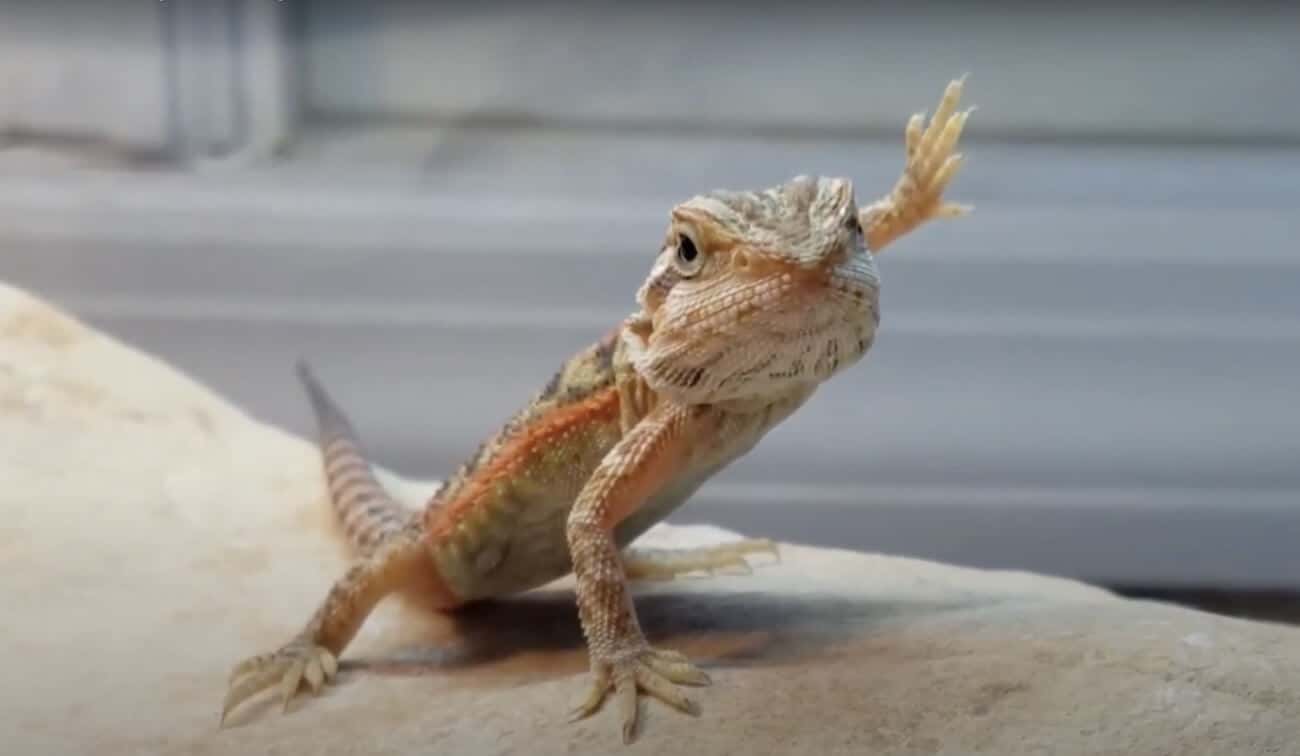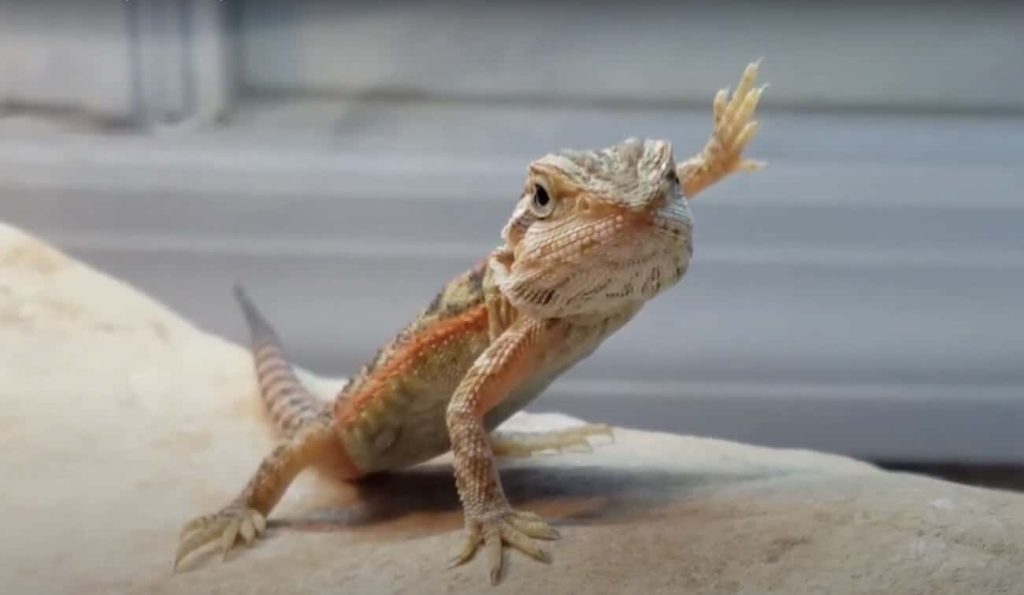Bearded dragons are one of the most popular pet reptiles in the world and they have a unique way of communicating with their owners. One of the most fascinating things that bearded dragons do is wave, which can leave many owners wondering what it means and why they do it.
If you have a bearded dragon that waves, you might be curious about why they do it. While there is no straightforward answer, there are several reasons why your bearded dragon might be waving. From greeting you to establishing dominance, waving is just one of the many ways that these fascinating creatures communicate with us.

Why Does My Bearded Dragon Wave?
If you own a bearded dragon, you may have noticed that they often wave their arms or legs at you. This quirky behavior may leave you wondering what it means. In this article, we will explore the reasons behind why your bearded dragon is waving.
Reason 1: Greeting
Bearded dragons are social creatures and they use waving as a way to greet each other. When they wave, they are essentially saying “hello” or “I am friendly”. If your bearded dragon is waving at you, it is likely trying to greet you and show you that it is comfortable around you.
It is important to note that not all bearded dragons will wave, and some may only wave in certain situations. For example, if your bearded dragon is feeling stressed or anxious, it may not wave as a way of trying to protect itself.
Reason 2: Submission
Another reason why bearded dragons wave is to show submission. When a bearded dragon feels threatened or intimidated, it may wave as a way of saying “I am not a threat”. This is because waving exposes their underbelly, which is a sign of vulnerability. By showing submission, they are trying to avoid conflict.
It is important to be aware of your bearded dragon’s body language and environment. If you notice that your bearded dragon is waving frequently or in situations where it may be feeling threatened, it may be a sign of stress or anxiety.
Reason 3: Attention-Seeking
Bearded dragons are intelligent creatures and they may wave as a way of getting your attention. If your bearded dragon wants food or to be let out of its enclosure, it may wave to get your attention. This is especially common in bearded dragons that are used to being hand-fed or spending a lot of time with their owners.
If you notice that your bearded dragon is waving frequently, it may be a sign that it needs more attention or stimulation. Make sure that your bearded dragon has plenty of toys and activities to keep it entertained.
Reason 4: Mating Behavior
Male bearded dragons may wave as a part of their mating behavior. When a male bearded dragon waves at a female, it is a way of signaling that it is interested in mating. The female may respond by waving back or by displaying other mating behaviors, such as head-bobbing or color changes.
If you have a male and female bearded dragon, it is important to be aware of their behavior and to separate them if you do not want them to breed.
Reason 5: Health Issues
In some cases, bearded dragons may wave as a sign of health issues. If your bearded dragon is waving excessively or in a way that seems abnormal, it may be a sign of illness or injury. Other signs of health issues in bearded dragons include lethargy, loss of appetite, and abnormal bowel movements.
If you are concerned about your bearded dragon’s health, it is important to take it to a veterinarian that specializes in reptiles.
Benefits of Understanding Your Bearded Dragon’s Behavior
By understanding why your bearded dragon is waving, you can better communicate with your pet and provide it with the care it needs. You can also identify potential health issues early on, which can improve your bearded dragon’s quality of life.
Conclusion
Bearded dragons are fascinating creatures and their behavior can be both entertaining and informative. By understanding why your bearded dragon is waving, you can deepen your relationship with your pet and provide it with the best care possible. Remember to always be aware of your bearded dragon’s body language and to seek veterinary care if you are concerned about its health.
Frequently Asked Questions
Bearded dragons are fascinating reptiles that make great pets. They have unique behaviors that often leave owners scratching their heads. One of these behaviors is waving. If you are wondering why your bearded dragon waves, we have the answers for you!
Why does my bearded dragon wave?
Bearded dragons wave for a few different reasons. The most common reason is to show submission. This is a sign of respect to other bearded dragons or to their owners. When a bearded dragon waves, they are essentially saying “I am not a threat to you”. This is their way of avoiding conflict.
Another reason a bearded dragon may wave is to show aggression. This is less common, but it does happen. If a bearded dragon feels threatened or uncomfortable, they may wave as a warning to stay away. If you notice your bearded dragon waving in a defensive manner, it is best to give them some space and try to identify the trigger for their behavior.
Is waving a sign of a healthy bearded dragon?
Yes, waving is a sign of a healthy bearded dragon. It is a natural behavior that is part of their communication system. However, if your bearded dragon is waving excessively or showing other signs of stress or illness, it may be a cause for concern. It is important to monitor your bearded dragon’s behavior and seek veterinary care if necessary.
In addition, waving can be a sign of a happy and content bearded dragon. If your bearded dragon waves at you when you approach their enclosure, it may be a sign that they recognize you and are comfortable with your presence.
Can I train my bearded dragon not to wave?
While waving is a natural behavior for bearded dragons, it is possible to train them not to wave. However, this should only be done if the waving is excessive or if it is causing stress or aggression. To train your bearded dragon not to wave, you can try desensitization techniques. This involves gradually exposing your bearded dragon to the triggers that cause them to wave, while rewarding them for not waving. It is important to be patient and consistent with your training, and to never punish your bearded dragon for waving.
It is also important to remember that waving is a form of communication for bearded dragons. If you train them not to wave, you may be missing out on an important way that they express themselves.
Are there any other behaviors I should watch for in my bearded dragon?
Yes, there are several other behaviors that are common in bearded dragons. These include head-bobbing, arm-waving, and tail-flicking. Each of these behaviors has a different meaning, and it is important to understand them in order to properly care for your bearded dragon.
Head-bobbing is a sign of dominance or aggression. Arm-waving, as we discussed earlier, is a sign of submission or aggression. Tail-flicking can be a sign of irritation or stress. By observing your bearded dragon’s behavior, you can better understand their needs and provide them with the care they require.
WHY Does Your Bearded Dragon Wave His Arm? Ask a REPTILE VET! ** Hint – It’s NOT What You Think!
In conclusion, the waving behavior in bearded dragons is a fascinating and complex phenomenon. While some experts believe it is a form of communication or a territorial display, others suggest that it may simply be a way for the lizard to regulate its body temperature or signal submission. Regardless of the exact reason for the behavior, one thing is clear: Bearded dragons are intelligent and highly social animals that are capable of expressing themselves in a variety of ways.
If you are a bearded dragon owner, it is important to pay attention to your pet’s body language and behavior to better understand their needs and emotions. By providing a comfortable and stimulating environment, regular interaction, and a nutritious diet, you can help ensure that your bearded dragon stays happy and healthy for years to come.
In the end, the waving behavior in bearded dragons is just one of many fascinating aspects of these amazing creatures. Whether you are a seasoned reptile enthusiast or a curious newcomer, there is always more to discover about these remarkable animals and the unique ways in which they interact with the world around them. So why does your bearded dragon wave? The answer may be more complex than you think, but one thing is for sure: It’s all part of what makes these lizards so special and beloved by so many.


